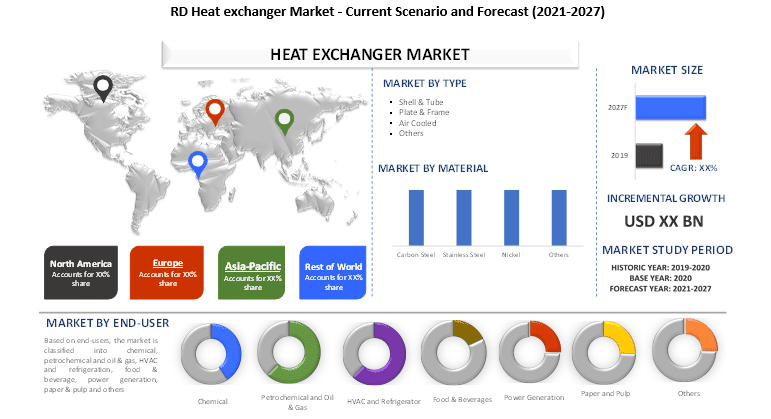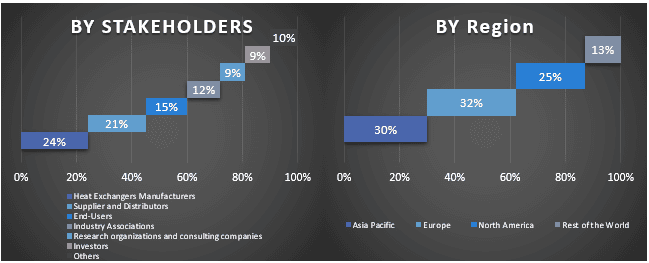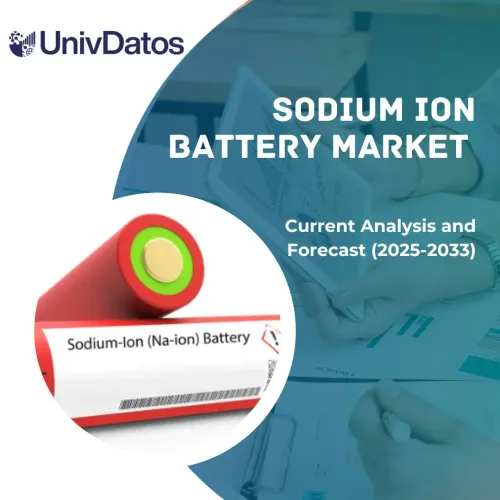- Home
- About Us
- Industry
- Services
- Reading
- Contact Us
Heat Exchanger Market: Current Analysis and Forecast (2021-2027)
Emphasis on Type (Shell & Tube, Plate & Frame, Air Cooled, and Others); Material (Carbon Steel, Stainless Steel, Nickel, and Others); End User (Chemical, Petrochemical and Oil & Gas, HVAC and Refrigeration, Food & Beverage, Power Generation, Paper & Pulp, and Others); Region/Country.

Global heat exchanger market was stood around US$ 15 billion in 2020 and is likely to demonstrate a CAGR of around 7% during the forecast period (2021-2027). Factors that are driving the market of heat exchanger includes is owing to rapidly growing power industry, industrial sector across various regions coupled with growing food and beverage industry had escalated the application of heat exchanger to frequently used to lessen or kill microbials.
The outbreak of COVID-19 had adverse impact on the heat exchanger market. According to World Investment report 2021, energy price shock early in 2020 also affected resource-based processing industries, halving the number of investment announcements in coke and refined petroleum, and reducing the value of announced projects by a third, to $30 billion. Hence, impacted the market size of heat exchanger as well.
Different Material of Heat exchanger, 2020

Alfa Laval, API Heat Transfer Inc, Danfoss, General Electric Company, Hisaka Works, IHI Corporation, Johnson Controls, Kelvion Holding GmbH, Koch Industries, Boyd Corporation. Several M&As along with partnerships have been undertaken by these players to facilitate customers with hi-tech and innovative products/technologies.
Insights Presented in the Report
“Amongst Material, stainless-steel segment held the major share”
Based on material, the heat exchanger market is divided into carbon steel, stainless steel, nickel and others. Stainless steel captured dominant share in the market and expected to have significant demand in the future as well. It is mainly owing to its beneficial characteristics of stainless steel such as resistance against corrosion in a wide range of pH levels, lightweight, high thermal conductivity, and no requirement of special fluids as it is compatible with plain clean water.
“Amongst End-Users, chemical segment holds the major share”
Based on end-users, the market is classified into chemical, petrochemical and oil & gas, HVAC and refrigeration, food & beverage, power generation, paper & pulp, and others. Recently, the chemical segment catered significant market share in the global heat exchanger market. As heat exchangers in chemicals are used in the manufacturing process which includes condensation of solvents, benzene heat recovery, cooling of water circuits, cooling of hydrocarbons, heating & cooling of intermediate products, heating and cooling of reactors, and production processes.
“Asia Pacific represents one of the largest markets of Global Heat exchanger Market”
For a better understanding of the market dynamics of the global heat exchanger market, a detailed analysis was conducted for different regions including Asia Pacific, North America, Europe and Rest of the World. Asia Pacific holds the extensive market share due to increasing industrial operations in the developing countries such as China, India, etc..
Reasons to buy this report:
- The study includes market sizing and forecasting analysis validated by authenticated key industry experts
- The report presents a quick review of overall industry performance at one glance
- The report covers an in-depth analysis of prominent industry peers with a primary focus on key business financials, product portfolio, expansion strategies, and recent developments
- Detailed examination of drivers, restraints, key trends, and opportunities prevailing in the industry
- The study comprehensively covers the market across different segments
- Deep dive regional level analysis of the industry
Customization Options:
Global Heat exchanger market can further be customized as per the requirement or any other market segment. Besides this, UMI understands that you may have your own business needs, hence feel free to connect with us to get a report that completely suits your requirements.
Table of Content
Analyzing the historical market, estimation of the current market, and forecasting the future market of the global heat exchanger market were the three major steps undertaken to create and analyze the adoption of heat exchanger in major regions globally. Exhaustive secondary research was conducted to collect the historical market numbers and estimate the current market size. Secondly, to validate these insights, numerous findings and assumptions were taken into consideration. Moreover, exhaustive primary interviews were also conducted, with industry experts across the value chain of the global heat exchanger market. Post assumption and validation of market numbers through primary interviews, we employed a top-down/bottom-up approach to forecasting the complete market size. Thereafter, market breakdown and data triangulation methods were adopted to estimate and analyze the market size of segments and sub-segments the industry pertains to. Detailed methodology is explained below:
Analysis of Historical Market Size
Step 1: In-Depth Study of Secondary Sources:
Detail secondary study was conducted to obtain the historical market size of heat exchanger market through company internal sources such as annual report & financial statements, performance presentations, press releases, etc., and external sources including journals, news & articles, government publications, competitor publications, sector reports, third-party database, and other credible publications.
Step 2: Market Segmentation:
After obtaining the historical market size of the heat exchanger market, we conducted a detailed secondary analysis to gather historical market insights and share for different segments & sub-segments for major regions. Major segments included in the report as type, material, and end-user. Further country-level analyses were conducted to evaluate the overall adoption of testing models in that region.
Step 3: Factor Analysis:
After acquiring the historical market size of different segments and sub-segments, we conducted a detailed factor analysis to estimate the current market size of heat exchanger market. Further, we conducted factor analysis using dependent and independent variables such as various material of heat exchanger and end-user of heat exchanger. A thorough analysis was conducted for demand and supply-side scenarios considering top partnerships, merger and acquisition, business expansion, and product launches in the heat exchanger market sector across the globe.
Current Market Size Estimate & Forecast
Current Market Sizing: Based on actionable insights from the above 3 steps, we arrived at the current market size, key players in the global heat exchanger market, and market shares of the segments. All the required percentage shares split, and market breakdowns were determined using the above-mentioned secondary approach and were verified through primary interviews.
Estimation & Forecasting: For market estimation and forecast, weights were assigned to different factors including drivers & trends, restraints, and opportunities available for the stakeholders. After analyzing these factors, relevant forecasting techniques i.e., top-down/bottom-up approach was applied to arrive at the market forecast about 2027 for different segments and sub-segments across the major markets globally. The research methodology adopted to estimate the market size encompasses:
- The industry’s market size, in terms of value (US$) and the adoption rate of heat exchanger market across the major markets domestically
- All percentage shares, splits, and breakdowns of market segments and sub-segments
- Key players in the global heat exchanger market in terms of solutions offered. Also, the growth strategies adopted by these players to compete in the fast-growing market
Market Size and Share Validation
Primary Research: In-depth interviews were conducted with the Key Opinion Leaders (KOLs) including Top Level Executives (CXO/VPs, Sales Head, Marketing Head, Operational Head, and Regional Head, Country Head, etc.) across major regions. Primary research findings were then summarized, and statistical analysis was performed to prove the stated hypothesis. Inputs from primary research were consolidated with secondary findings, hence turning information into actionable insights.
Split of Primary Participants in Different Regions
Market Engineering
Data triangulation technique was employed to complete the overall market estimation and to arrive at precise statistical numbers of each segment and sub-segment of the global Heat exchanger market. Data was split into several segments & sub-segments post studying various parameters and trends in the areas of type, material, and end-users of the heat exchanger.
The main objective of the Global Heat exchanger Market Study
The current & future market trends of global heat exchanger market were pinpointed in the study. Investors can gain strategic insights to base their discretion for investments from the qualitative and quantitative analysis performed in the study. Current and future market trends were determined the overall attractiveness of the market at a regional level, providing a platform for the industrial participant to exploit the untapped market to benefit as a first-mover advantage. Other quantitative goals of the studies include:
- Analyze the current and forecast market size of heat exchanger market in terms of value (US$). Also, analyze the current and forecast market size of different segments and sub-segments
- Segments in the study include areas of type, material, and end-user.
- Define and analysis of the regulatory framework for the heat exchanger market industry.
- Analyze the value chain involved with the presence of various intermediaries, along with analyzing customer and competitor behaviors of the industry.
- Analyze the current and forecast market size of the heat exchanger market for the major region.
- Major regions studied in the report include Asia Pacific, Europe, North America, and Rest of the world.
- Company profiles of the heat exchanger market and the growth strategies adopted by the market players to sustain in the fast-growing market
Deep dive regional level analysis of the industry
Related Reports
Customers who bought this item also bought










